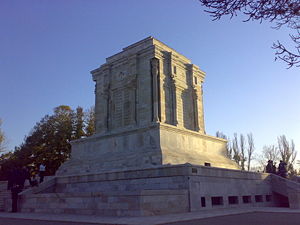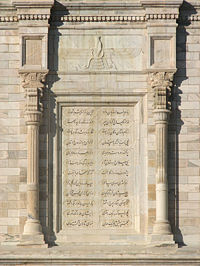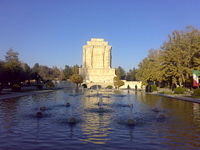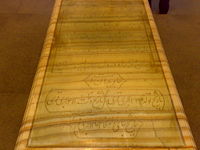Difference between revisions of "Ferdowsi" - New World Encyclopedia
(credit Wiki) |
|||
| Line 53: | Line 53: | ||
According to the Encyclopedia Britannica:''The Persians regard Ferdowsi as the greatest of their poets. For nearly a thousand years they have continued to read and to listen to recitations from his masterwork, the Shah-nameh, in which the Persian national epic found its final and enduring form. Though written about 1,000 years ago, this work is as intelligible to the average, modern Iranian as the King James version of the Bible is to a modern English-speaker. The language, based as the poem is on a Pahlavi original, is pure Persian with only the slightest admixture of Arabic''.<ref>"Ferdowsi." Encyclopædia Britannica. 2007. Encyclopædia Britannica Online. 4 June 2007 <http://search.eb.com/eb/article-9034029></ref> | According to the Encyclopedia Britannica:''The Persians regard Ferdowsi as the greatest of their poets. For nearly a thousand years they have continued to read and to listen to recitations from his masterwork, the Shah-nameh, in which the Persian national epic found its final and enduring form. Though written about 1,000 years ago, this work is as intelligible to the average, modern Iranian as the King James version of the Bible is to a modern English-speaker. The language, based as the poem is on a Pahlavi original, is pure Persian with only the slightest admixture of Arabic''.<ref>"Ferdowsi." Encyclopædia Britannica. 2007. Encyclopædia Britannica Online. 4 June 2007 <http://search.eb.com/eb/article-9034029></ref> | ||
| + | |||
| + | ==Notes== | ||
| + | {{reflist}} | ||
==References== | ==References== | ||
| − | |||
| − | * | + | * Browne, Edward Granville. 1999. ''A literary history of Persia. 1, From the earliest times until Firdawsi.'' Library of literary history, 6. Richmond, Surrey: Curzon. ISBN 9780700704064. |
| − | * | + | * Firdawsī, and Jerome W. Clinton. 1987. ''The tragedy of Sohráb and Rostám: from the Persian national epic, the Shahname of Abol-Qasem Ferdowsi.'' Publications on the Near East, University of Washington, no. 3. Seattle: University of Washington Press. ISBN 9780295965772. |
| + | * Firdawsī, and Dick Davis. 2006.'' Shahnameh: the Persian book of kings.'' New York: Viking. ISBN 9780670034857. | ||
| + | * Shahbāzī, ʻA. Shāpūr. 1991.'' Ferdowsī: a critical biography.'' Cambridge, Mass: Harvard University, Center for Middle Eastern Studies. ISBN 9780939214839. | ||
==See also== | ==See also== | ||
Revision as of 18:46, 17 January 2009
Hakīm Abū l-Qāsim Firdawsī Tūsī (Persian: حکیم ابوالقاسم فردوسی توسی), more commonly transliterated as Ferdowsi, (935–1020) was a highly revered Persian poet. He was the author of the Shāhnāmeh, the national epic of Persian-speaking world as well as the entire Iranian realm.
Life
Ferdowsi was born in 935 in a village near Tus, in Greater Khorasan (now part of the Iranian province Razavi Khorasan).
The son of a wealthy land owner, his great epic, the Shāhnāmeh ("The Epic of Kings"), to which he devoted more than 35 years, was originally composed for presentation to the Samanid princes of Khorasan, who were the chief instigators of the revival of Iranian cultural traditions after the Arab conquest of the seventh century.
When he was just 23-years old, he found a “Shāhnāmeh” written by Abu-Mansour Almoammari; it was not, however, in poetic form. It consisted of older versions ordered by Abu-Mansour ibn Abdol-razzagh. The discovery would be a fateful moment in the life of the poet. Ferdowsi started his composition of the Shahnameh in the Samanid era in 977 C.E.[1]. During Ferdowsi’s lifetime the Samanid dynasty was conquered by the Ghaznavid Empire.
After 30 years of hard work, he finished the book and two or three years after that, Ferdowsi went to Ghazni, the Ghaznavid capital, to present it to the king. There are various stories in medieval texts describing the lack of interest shown by the new king, Sultan Mahmud of Ghazni, in Ferdowsi and his lifework. According to historians, Mahmud had promised Ferdowsi a dinar for every distich written in the Shahnameh (60,000 dinars), but later retracted and presented him with dirhams (20,000 dirhams), which were at that time much less valuable than dinars (every 100 dirhams worth 1 dinar). Some think it was the jealousy of other poets working at the king’s court that led to this treachery; the incident encouraged Ferdowsi's enemies in the court. Ferdowsi rejected the money and, by some accounts, he gave it to a poor man who sold wine. Wandering for a time in Sistan and Mazandaran, he eventually returned to Tus, heartbroken and enraged.
He had left behind a poem for the King, stuck to the wall of the room he had worked in for all those years. It was a long and angry poem, more like a curse, and ended with the words:
"Heaven's vengeance will not forget. Shrink tyrant from my words of fire, and tremble at a poet's ire."
Ferdowsi is said to have died around 1020 in poverty at the age of 90, embittered by royal neglect, though fully confident of his work’s ultimate success and fame (clearly seen especially in last verses of his book). One tradition claims Mahmud re-sent the amount promised to Ferdowsi’s village, but when the messengers reached his house, he had died a few hours earlier. The gift was then given to his daughter, since his son had died before his father at the age of 37. However, his daughter refused to receive the sum, thus making Ferdowsi’s Shahnameh immortal.
Later the king ordered the money be used for repairing an inn in the way from Merv to Tus, named “Robat Chaheh” so that it may remain in remembrance of the poet. This inn now lies in ruins, but still exists.
Some say that Ferdowsi's daughter inherited her father's hard earned money, and she built a new and strong bridge with a beautiful stone caravanserai nearby for travellers to rest and trade and tell stories.[2]
Ferdowsi was buried at the yard of his own home, where his mausoleum now lies. It was not until Reza Shah Pahlavi's rule, in 1925, that a mausoleum was built for the great poet.
Ferdowsi and religion
Ferdowsi was a Shia Muslim, which is apparent from the Shahnameh itself and confirmed by early accounts.[3] On the one hand, he was lenient as regards religion. As Nöldeke remarks, Ferdowsi remembered the religion of his forbears with respect, and, at the same time, nowhere did he show any signs of a deep Islamic faith. Indeed, to the contrary, here and there are moments in the Shahnameh which, even if they were present in his sources, should not strictly have been given currency by the pen of a committed Muslim[4]. On the other hand, however, he also showed a prejudice in favor of his own sect (i.e. Shi'ism) and, as is apparent from the exordium to the Shahnameh, considered his own sect to be the only true Islamic one. The explanation for this contradiction lies in the fact that during the first centuries of Islam, in Persia, Shi'ism went hand in hand with the national struggle in Khorasan, or very nearly so, such that the caliphate in Baghdad and its political supporters in Persia never made any serious distinction between the "Majūs" (Zoroastrians), "Zandīq" (Manicheans), "Qarmatīs" (Isma'ili Shi'ism), and "Rāfezīs" (Shias in general)[3]
Books
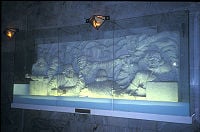
His masterpiece, the Shāhnāmeh, is the most popular and influential national epics belonging to the Iranian people that at one time made up the greater Persian Empire, named in Prophet Zarathustra's Gatha as Airyanem Vaejah, in Shahnameh as Iran, and in Greek as Persian Empire. In this context we use "Persians" to denote what the Greeks viewed as the people of Airyanem Vaejah and the word Persia for all its territories. Thus the greatest achievement of Ferdowsi is to have all of the named fragments of the former Persian Empire, once again recite together "if there is no Iran, may my body be vanquished, and in this land and nation no one remain alive, if everyone of us dies one by one, it is better than giving our country to the enemy." If there is a single document in the Persian literature that can reunite Persia and all of its nations, it is this document.
The Shāhnāmeh, or the "Book of Kings," consists of the translation of an even older Pahlavi (Middle Persian) work. It has remained exceptionally popular among Persians for over a thousand years. It tells the history of old Persia before the Arab conquest of the region. This tale, all written in poetic form and in Darī Persian, starts 7,000 years ago, narrating the story of Persian kings, Persian knights, Persian system of laws, Persian Religion, Persian victories and Persian tragedies.
Illustrations, especially those of Mahmoud Farshchian, are historical and use the different themes for the stories.
According to popular legend, Ferdowsi was commissioned by Sultan Mahmud of Ghazni to write a book about his valour and conquests. However, the poet, though dedicating the book to the King for an agreed fee of 30 horses loaded with gold coins, decided to tell the story of the Kings that had made the land of Persia into an Empire throughout the ages. This task was to take the poet some thirty years or more, during which he included the verse:
| “ | ... I suffered during these thirty years, but I have revived the Iranians (Ajam) with the Persian language; I shall not die since I am alive again, as I have spread the seeds of this language ... | ” |
Upon the presentation of the Shāhnāmeh, Sultan Mahmud was furious for not being the subject of the book and finally betrayed the agreement by offering Ferdowsi thirty camels loaded with Silver; the offer was refused by the poet. Heartbroken and poor the poet returned to his home town of Tus, the Sultan eventually realising his error and the true value of the Shāhnāmeh sent the agreed fee to the poet yet, upon the arrival of the camels the Ferdowsi's coffin was being carried out through the exit gate of Tus to his grave.
Influence
Ferdowsi is one of the undisputed giants of Persian literature. After Ferdowsi's Shāhnāmeh a number of other works similar in nature surfaced over the centuries within the cultural sphere of the Persian language. Without exception, all such works were based in style and method on Ferdowsi's Shāhnāmeh, but none of them could quite achieve the same degree of fame and popularity as Ferdowsi's masterpiece.
Ferdowsi has a unique place in Persian history because of the strides he made in reviving and regenerating the Persian language and cultural traditions. His works are cited as a crucial component in the persistence of the Persian language, as those works allowed much of the tongue to remain codified and intact. In this respect, Ferdowsi surpasses Nezami, Khayyam, Asadi Tusi, and other seminal Persian literary figures in his impact on Persian culture and language. Many modern Iranians see him as the father of the modern Persian language.
According to the Encyclopedia Britannica:The Persians regard Ferdowsi as the greatest of their poets. For nearly a thousand years they have continued to read and to listen to recitations from his masterwork, the Shah-nameh, in which the Persian national epic found its final and enduring form. Though written about 1,000 years ago, this work is as intelligible to the average, modern Iranian as the King James version of the Bible is to a modern English-speaker. The language, based as the poem is on a Pahlavi original, is pure Persian with only the slightest admixture of Arabic.[5]
Notes
- ↑ Encyclopedia Iranica, [1], Ferdowsi, Djalal Khaleghi-Motlagh
- ↑ Life of Ferdowsi
- ↑ 3.0 3.1 Ferdowsi, in Encyclopaedia Iranica
- ↑ Nöldeke, 1920, pp. 38-39
- ↑ "Ferdowsi." Encyclopædia Britannica. 2007. Encyclopædia Britannica Online. 4 June 2007 <http://search.eb.com/eb/article-9034029>
ReferencesISBN links support NWE through referral fees
- Browne, Edward Granville. 1999. A literary history of Persia. 1, From the earliest times until Firdawsi. Library of literary history, 6. Richmond, Surrey: Curzon. ISBN 9780700704064.
- Firdawsī, and Jerome W. Clinton. 1987. The tragedy of Sohráb and Rostám: from the Persian national epic, the Shahname of Abol-Qasem Ferdowsi. Publications on the Near East, University of Washington, no. 3. Seattle: University of Washington Press. ISBN 9780295965772.
- Firdawsī, and Dick Davis. 2006. Shahnameh: the Persian book of kings. New York: Viking. ISBN 9780670034857.
- Shahbāzī, ʻA. Shāpūr. 1991. Ferdowsī: a critical biography. Cambridge, Mass: Harvard University, Center for Middle Eastern Studies. ISBN 9780939214839.
See also
Template:Wikisourceauthor
- Shāhnāmeh
- List of Persian poets and authors
- Persian literature
- Sassanid dynasty
- Iranistics
- List of mausoleums
- Jerry Clinton
External links
- Khosrow Nāghed, In the Workshop of Thought and Imagination of the Master of Tūs (Dar Kargāh-e Andisheh va Khiāl-e Ostād-e Tūs), in Persian, Radio Zamāneh, August 5, 2008.
Template:Shahnameh
| |||||||||||||||||||||||||||||||||||||||||||||||||||||||
ar:فردوسي az:Əbülqasım Firdovsi bs:Firdusi br:Ferdowsi bg:Фирдоуси ca:Firdawsī ceb:Ferdowsi cs:Firdausí cy:Ferdawsi da:Firdausi de:Firdausi et:Abu'l-Kasim Firdausi es:Ferdowsi eo:Abol-Gasem Ferdoŭsio eu:Ferdowsi fa:فردوسی fr:Ferdowsi hi:फ़िरदौसी id:Ferdowsi is:Ferdowsi it:Ferdowsi he:פירדוסי ka:ფირდოუსი sw:Firdusi ku:Firdewsî la:Firdausi hu:Firdauszí ms:Hakim Abul Qasim Firdausi Tusi mn:Фирдоуси nl:Ferdowsi ja:フェルドウスィー no:Firdausi pl:Ferdousi pt:Ferdusi kaa:A'bilqasım Ferdawsiy ru:Фирдоуси simple:Ferdowsi sl:Firdusi sv:Firdausi te:ఫిరదౌసి tg:Абулқосими Фирдавсӣ tr:Firdevsi uk:Фірдоусі vo:Ferdowsi war:Firdawsi bat-smg:Fėrdousės zh:菲爾多西
Credits
New World Encyclopedia writers and editors rewrote and completed the Wikipedia article in accordance with New World Encyclopedia standards. This article abides by terms of the Creative Commons CC-by-sa 3.0 License (CC-by-sa), which may be used and disseminated with proper attribution. Credit is due under the terms of this license that can reference both the New World Encyclopedia contributors and the selfless volunteer contributors of the Wikimedia Foundation. To cite this article click here for a list of acceptable citing formats.The history of earlier contributions by wikipedians is accessible to researchers here:
The history of this article since it was imported to New World Encyclopedia:
Note: Some restrictions may apply to use of individual images which are separately licensed.
